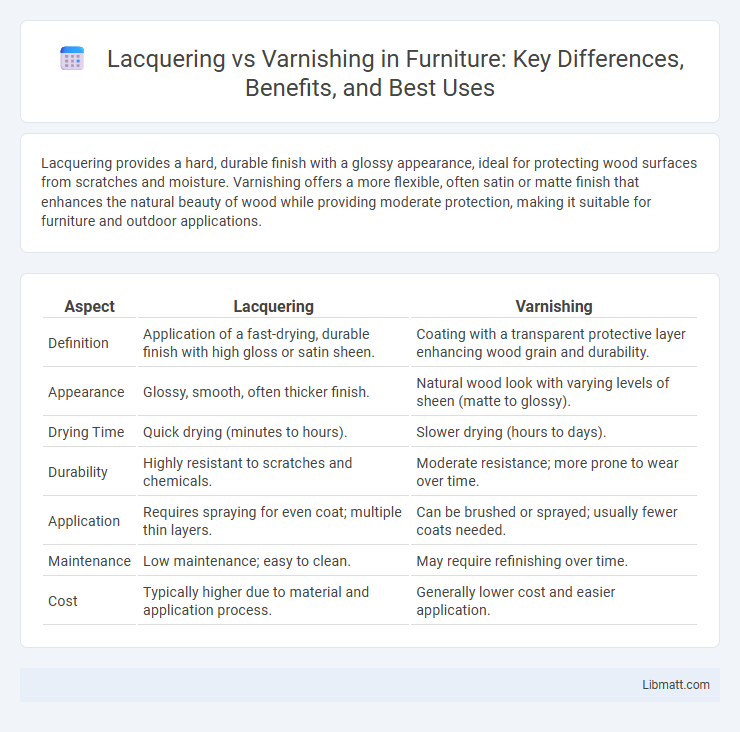Lacquering provides a hard, durable finish with a glossy appearance, ideal for protecting wood surfaces from scratches and moisture. Varnishing offers a more flexible, often satin or matte finish that enhances the natural beauty of wood while providing moderate protection, making it suitable for furniture and outdoor applications.
Table of Comparison
| Aspect | Lacquering | Varnishing |
|---|---|---|
| Definition | Application of a fast-drying, durable finish with high gloss or satin sheen. | Coating with a transparent protective layer enhancing wood grain and durability. |
| Appearance | Glossy, smooth, often thicker finish. | Natural wood look with varying levels of sheen (matte to glossy). |
| Drying Time | Quick drying (minutes to hours). | Slower drying (hours to days). |
| Durability | Highly resistant to scratches and chemicals. | Moderate resistance; more prone to wear over time. |
| Application | Requires spraying for even coat; multiple thin layers. | Can be brushed or sprayed; usually fewer coats needed. |
| Maintenance | Low maintenance; easy to clean. | May require refinishing over time. |
| Cost | Typically higher due to material and application process. | Generally lower cost and easier application. |
Introduction to Lacquering and Varnishing
Lacquering and varnishing are popular wood finishing techniques that enhance durability and appearance by creating a protective layer. Lacquers dry quickly and provide a hard, glossy surface ideal for furniture and musical instruments, while varnishes offer thicker coatings with superior water and UV resistance, suitable for exterior woodwork. Understanding the differences in drying time, finish, and protection helps you select the optimal finish for your project's needs.
Understanding the Basics: Lacquer vs Varnish
Lacquer and varnish are popular wood finishes with distinct properties and applications, where lacquer offers a fast-drying, durable, and high-gloss finish ideal for furniture and musical instruments. Varnish provides a thicker, more flexible coating resistant to weather and UV damage, making it suitable for outdoor use and protecting wood surfaces over time. Understanding their chemical compositions--lacquer primarily contains nitrocellulose or acrylic, while varnish consists of oil, resin, and solvents--helps in selecting the appropriate finish based on durability, appearance, and environmental exposure requirements.
Key Differences in Composition
Lacquering primarily consists of nitrocellulose or acrylic compounds dissolved in solvents, forming a hard, durable, and glossy finish rapidly upon drying. Varnishing involves a combination of resins, oils, and solvents, resulting in a thicker, more flexible coating that cures slowly and enhances wood's natural texture. The key difference lies in lacquer's fast-evaporating solvents for quick drying, whereas varnish uses slower-drying oils for prolonged curing and deeper protection.
Application Techniques Compared
Lacquering involves spraying or brushing multiple thin coats that dry quickly, providing a smooth, durable finish often used for furniture and musical instruments. Varnishing typically requires brushing on thicker layers that cure more slowly, enhancing wood grain with increased protection against moisture and UV damage. Your choice between these techniques depends on the desired finish texture, drying time, and the level of durability needed for the project.
Durability and Protection
Lacquering offers superior durability and protection by creating a hard, resilient surface that resists scratches, chemicals, and wear better than varnishing. Varnish provides a flexible and water-resistant coating that enhances wood's natural beauty but is generally less resistant to impact and abrasion. Choosing lacquering for Your project ensures long-lasting defense against environmental damage and daily use.
Aesthetic Outcomes: Finish and Appearance
Lacquering produces a smooth, glossy finish that enhances the depth and richness of wood grain, offering vibrant color clarity and a polished appearance. Varnishing tends to provide a warm, natural look with a slightly satin or matte finish that retains texture while protecting the surface from wear. Your choice depends on whether you prefer a high-shine, reflective effect or a subtler, textured aesthetic for your woodwork.
Drying and Curing Times
Lacquering typically dries faster than varnishing, often becoming touch-dry within 15 to 30 minutes, while varnish can take several hours to dry fully. Curing time for lacquer is also shorter, usually completing in a few days, compared to varnish which may require up to a week or more for full hardness and durability. Choosing lacquer or varnish depends on your project's timeline and the desired finish resilience.
Maintenance and Longevity
Lacquering provides a hard, durable surface that resists scratches and moisture, resulting in easier maintenance and extended longevity compared to varnishing. Varnish, while offering good protection, often requires more frequent reapplication and touch-ups to maintain its appearance and effectiveness. Properly applied lacquer can maintain its glossy finish for years with minimal care, making it ideal for high-use furniture and surfaces.
Ideal Uses: When to Choose Lacquer or Varnish
Lacquer is ideal for furniture and musical instruments requiring a smooth, glossy finish and fast drying times, making it suitable for indoor applications where appearance is paramount. Varnish excels in outdoor projects like decks, boats, and exterior woodwork, offering superior durability and protection against UV rays and moisture. Choose lacquer for quick, high-gloss indoor finishes and varnish for long-lasting, weather-resistant coatings on exterior surfaces.
Environmental and Safety Considerations
Lacquering typically involves solvents that emit higher levels of volatile organic compounds (VOCs), contributing to air pollution and posing health risks such as respiratory irritation and dizziness. Varnishing products often contain lower VOC levels and can include water-based formulas, making them a safer and more environmentally friendly option for your woodworking projects. Choosing varnish reduces harmful emissions and improves indoor air quality, protecting both your health and the environment.
lacquering vs varnishing Infographic

 libmatt.com
libmatt.com